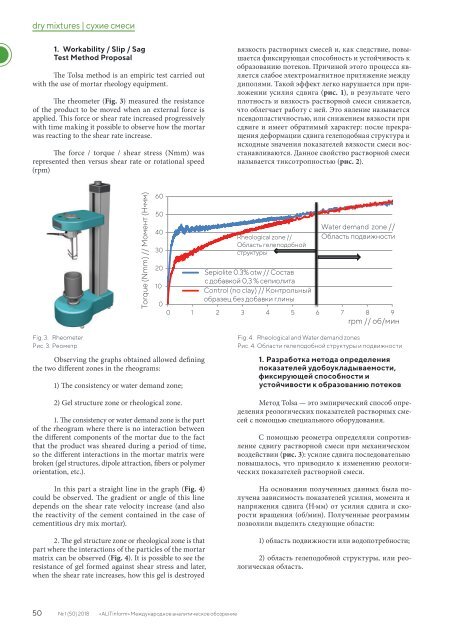AlitInform 50
“ALITinform” is a periodical that covers different aspects in production and applications of cement, concrete, and dry building mixtures. Pages of this journal offer contributions from leading Russian and International scientists, technologists and leading professionals, news from the stock markets, research laboratories, latest elaborations by producers and suppliers of modern building materials and equipment. The magazine goal is to unite on its pages the articles of the leading Russian and International specialists in the field of cement, concrete, dry building mixtures; latest news of the Russian and world building materials market, the traditions of peer-reviewed Russian scientific magazines and innovative informational approach of the contemporary printed media. The prime focus is on developments serving the purpose of rationalization of production, reduction of energy consumption, enhancement of quality and improvement of environmental safety. _______________________________________
“ALITinform” is a periodical that covers different aspects in production and applications of cement, concrete, and dry building mixtures. Pages of this journal offer contributions from leading Russian and International scientists, technologists and leading professionals, news from the stock markets, research laboratories, latest elaborations by producers and suppliers of modern building materials and equipment.
The magazine goal is to unite on its pages the articles of the leading Russian and International specialists in the field of cement, concrete, dry building mixtures; latest news of the Russian and world building materials market, the traditions of peer-reviewed Russian scientific magazines and innovative informational approach of the contemporary printed media. The prime focus is on developments serving the purpose of rationalization of production, reduction of energy consumption, enhancement of quality and improvement of environmental safety.
_______________________________________
You also want an ePaper? Increase the reach of your titles
YUMPU automatically turns print PDFs into web optimized ePapers that Google loves.
dry mixtures | сухие смеси<br />
1. Workability / Slip / Sag<br />
Test Method Proposal<br />
The Tolsa method is an empiric test carried out<br />
with the use of mortar rheology equipment.<br />
The rheometer (Fig. 3) measured the resistance<br />
of the product to be moved when an external force is<br />
applied. This force or shear rate increased progressively<br />
with time making it possible to observe how the mortar<br />
was reacting to the shear rate increase.<br />
The force / torque / shear stress (Nmm) was<br />
represented then versus shear rate or rotational speed<br />
(rpm)<br />
вязкость растворных смесей и, как следствие, повышается<br />
фиксирующая способность и устойчивость к<br />
образованию потеков. Причиной этого процесса является<br />
слабое электромагнитное притяжение между<br />
диполями. Такой эффект легко нарушается при приложении<br />
усилия сдвига (рис. 1), в результате чего<br />
плотность и вязкость растворной смеси снижается,<br />
что облегчает работу с ней. Это явление называется<br />
псевдопластичностью, или снижением вязкости при<br />
сдвиге и имеет обратимый характер: после прекращения<br />
деформации сдвига гелеподобная структура и<br />
исходные значения показателей вязкости смеси восстанавливаются.<br />
Данное свойство растворной смеси<br />
называется тиксотропностью (рис. 2).<br />
Torque (Nmm) // Момент (Н·мм)<br />
60<br />
<strong>50</strong><br />
40<br />
30<br />
Rheological zone //<br />
Область гелеподобной<br />
структуры<br />
Water demand zone //<br />
Область подвижности<br />
20<br />
Sepiolite 0.3% otw // Состав<br />
10<br />
с добавкой 0,3 % сепиолита<br />
Control (no clay) // Контрольный<br />
0<br />
образец без добавки глины<br />
0 1 2 3 4 5 6 7 8 9<br />
rpm // об/мин<br />
Fig. 3. Rheometer<br />
Рис. 3. Реометр<br />
Observing the graphs obtained allowed defining<br />
the two different zones in the rheograms:<br />
1) The consistency or water demand zone;<br />
2) Gel structure zone or rheological zone.<br />
1. The consistency or water demand zone is the part<br />
of the rheogram where there is no interaction between<br />
the different components of the mortar due to the fact<br />
that the product was sheared during a period of time,<br />
so the different interactions in the mortar matrix were<br />
broken (gel structures, dipole attraction, fibers or polymer<br />
orientation, etc.).<br />
In this part a straight line in the graph (Fig. 4)<br />
could be observed. The gradient or angle of this line<br />
depends on the shear rate velocity increase (and also<br />
the reactivity of the cement contained in the case of<br />
cementitious dry mix mortar).<br />
2. The gel structure zone or rheological zone is that<br />
part where the interactions of the particles of the mortar<br />
matrix can be observed (Fig. 4). It is possible to see the<br />
resistance of gel formed against shear stress and later,<br />
when the shear rate increases, how this gel is destroyed<br />
Fig. 4. Rheological and Water demand zones<br />
Рис. 4. Области гелеподобной структуры и подвижности<br />
1. Разработка метода определения<br />
показателей удобоукладываемости,<br />
фиксирующей способности и<br />
устойчивости к образованию потеков<br />
Метод Tolsa — это эмпирический способ определения<br />
реологических показателей растворных смесей<br />
с помощью специального оборудования.<br />
С помощью реометра определяли сопротивление<br />
сдвигу растворной смеси при механическом<br />
воздействии (рис. 3): усилие сдвига последовательно<br />
повышалось, что приводило к изменению реологических<br />
показателей растворной смеси.<br />
На основании полученных данных была получена<br />
зависимость показателей усилия, момента и<br />
напряжения сдвига (Н·мм) от усилия сдвига и скорости<br />
вращения (об/мин). Полученные реограммы<br />
позволили выделить следующие области:<br />
1) область подвижности или водопотребности;<br />
2) область гелеподобной структуры, или реологическая<br />
область.<br />
<strong>50</strong> № 1 (<strong>50</strong>) 2018 «ALITinform» Международное аналитическое обозрение



